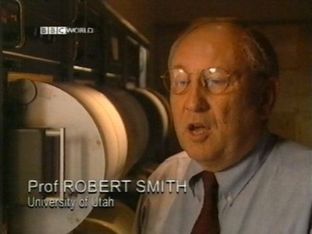Horizon
Supervolcanoes (2000x4)
:
Hidden deep beneath the Earth's surface lie one of the most destructive and yet least-understood natural phenomena in the world - supervolcanoes. Only a handful exist in the world but when one erupts it will be unlike any volcano we have ever witnessed. The explosion will be heard around the world. The sky will darken, black rain will fall, and the Earth will be plunged into the equivalent of a nuclear winter.
Normal volcanoes are formed by a column of magma - molten rock - rising from deep within the Earth, erupting on the surface, and hardening in layers down the sides. This forms the familiar cone shaped mountain we associate with volcanoes. Supervolcanoes, however, begin life when magma rises from the mantle to create a boiling reservoir in the Earth's crust. This chamber increases to an enormous size, building up colossal pressure until it finally erupts.
The last supervolcano to erupt was Toba 74,000 years ago in Sumatra. Ten thousand times bigger than Mt St Helens, it created a global catastrophe dramatically affecting life on Earth. Scientists know that another one is due - they just don't know when... or where.
Yellowstone National Park: It is little known that lying underneath one of America's areas of outstanding natural beauty - Yellowstone Park - is one of the largest supervolcanoes in the world. Scientists have revealed that it has been on a regular eruption cycle of 600,000 years. The last eruption was 640,000 years ago... so the next is overdue.
And the sleeping giant is breathing: volcanologists have been tracking the movement of magma under the park and have calculated that in parts of Yellowstone the ground has risen over seventy centimetres this century. Is this just the harmless movement of lava, flowing from one part of the reservoir to another? Or does it presage something much more sinister, a pressurised build-up of molten lava?
Scientists have very few answers, but they do know that the impact of a Yellowstone eruption is ter
